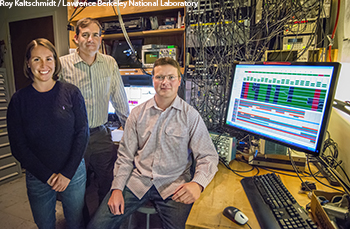
Sydney Schreppler, Dan Stamper-Kum and Nicolas Spethmann in their laser lab in Birge Hall at UC Berkeley.
Using lasers and a unique optical trap, U.S. physicists at the University of California, Berkeley (UC Berkeley) and Lawrence Berkeley National Laboratory have detected what is believed to be the smallest force ever measured (Science, DOI: 10.1126/science.1249850). The force of 42 yoctonewtons is the closest-ever measurement to the standard quantum limit, the barrier at which the noise of the detector equals the force being measured. A yoctonewton is one septillionth of a newton.
To reduce this noise and achieve record sensitivity, professor of physics at UC Berkeley and Berkeley Lab’s Materials Sciences Division Dan Stamper-Kurn and colleagues created a mechanical oscillator element consisting of 1,200 ultrachilled rubidium atoms in an optical trap. The trap is formed by two standing-wave light fields at 840 and 860 nm that apply equal and opposite axial forces on the cloud of atoms. The team applied a calibrated optical-dipole force to the cloud to induce center-of-mass motion. They then measured the resulting motion optically via a weak 780-nm probe beam and a heterodyne receiver to a factor of four above the standard quantum limit.
According to lead author and graduate student Sydney Schreppler, the laser light used to create the optical trap isolates the atoms from their environment without heating them. This allows for a precision measurement when the probe power balances photon shot-noise against the disturbance of measurement back-action.
Even more sensitive measurements may be possible with colder atoms and could enable direct detection of gravitational waves from astronomical sources, improved atomic force microscopy, and probing of the effect of Newtonian gravity on quantum systems.
